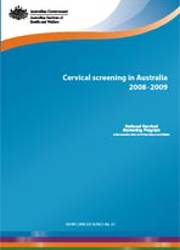Report editions
Newer releases
-
Cervical screening in Australia 2019
Publication |
-
Cervical screening in Australia 2018
Publication |
-
Cervical screening in Australia 2014–2015
Publication |
-
Cervical screening in Australia 2013–2014
Publication |
-
Cervical screening in Australia 2012–2013
Publication |
-
Cervical screening in Australia 2011-2012
Publication |
-
Cervical screening in Australia 2010-2011
Publication |
-
Cervical screening in Australia 2009-2010
Publication |
This release
Cervical screening in Australia 2008-2009
Previous releases
-
Cervical screening in Australia 2007-2008
Publication |
-
Cervical screening in Australia 2006-2007
Publication |
-
Cervical screening in Australia 2005-2006
Publication |
-
Cervical screening in Australia 2004-2005
Publication |
-
Cervical screening in Australia 2003-2004
Publication |
-
Cervical screening in Australia 2002-2003
Publication |
-
Cervical screening in Australia 2001-02
Publication |
-
Cervical screening in Australia 2000-2001 and 1999-2000
Publication |
-
Cervical screening in Australia 1999-2000
Publication |
-
Cervical screening in Australia 1998-1999
Publication |
-
Cervical screening in Australia 1997-1998
Publication |



